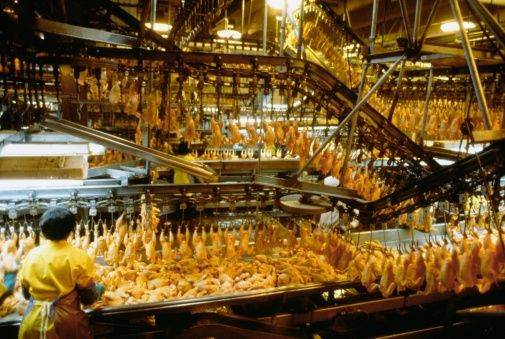USDA Approves Controversial New Poultry Inspection Overhaul

The U.S. Department of Agriculture has released the final version of a controversial rule to overhaul national poultry inspection standards. The rule released Thursday afternoon puts an end to more than two years of wrangling among the USDA, the poultry industry and health and food safety advocates over how best to reform the nation’s poultry inspection regime for the first time in more than five decades.
“The United States has been relying on a poultry inspection model that dates back to 1957, while rates of foodborne illness due to salmonella and campylobacter remain stubbornly high,” USDA Secretary Tom Vilsack said in a statement. “The system we are announcing today imposes stricter requirements on the poultry industry and places our trained inspectors where they can better ensure food is being processed safely.”
The agency hopes the new regulations will prevent 5,000 foodborne illnesses each year through the implementation of its New Poultry Inspection System (NPIS), which it describes as “an updated science-based inspection system that positions food safety inspectors throughout poultry facilities in a smarter way.”
But food safety advocates worry that the rule will have the opposite effect. The advocacy group Food & Water Watch said in a Wednesday statement that the rule will leave consumers much less protected from foodborne illnesses.
“Today, the U.S. Department of Agriculture released the final rule that will transfer most poultry inspection from government inspectors to the companies so they can police themselves,” the statement said, adding that “the plan is a gift from the Obama administration to the industry, one that will undermine consumer and worker safety, as well as animal welfare.”
The new rule would reduce the number of USDA inspectors working in chicken and turkey production plants by about one-fourth, transferring most of the task of ensuring that poultry is safe for consumption to plants' employees.
The USDA’s Food Safety and Inspection Service (FSIS) said in the Wednesday statement that while its inspectors will be occupying a lesser role on poultry processing lines -- where they currently watch for signs of illness, fecal matter and other potential food safety concerns -- the smaller force of inspectors that remains will be more effective in preventing the spread of salmonella and other pathogens.
“FSIS will now require that all poultry companies take measures to prevent salmonella and campylobacter contamination, rather than addressing contamination after it occurs,” FSIS said. “Also for the first time ever, all poultry facilities will be required to perform their own microbiological testing at two points in their production process to show that they are controlling salmonella and campylobacter.”
The final rule will cap the line speed at poultry processors at the current rate of 140 birds per minute. An earlier plan would have increased the top speed to 175 birds per minute, but strong pushback during the rule's public comment period led to the lower cap.
As of today, each USDA inspector is permitted to inspect no more than 35 chicken carcasses per minute. A line running at maximum speed, therefore, must have four licensed USDA inspectors on duty at all times. Under the new rule, only one inspector -- employed by the owner of the processing plant in which he or she is posted -- would be required.
In its Wednesday statement, Food & Water Watch said that “the one USDA inspector left on the slaughter line under this new rule will still have to inspect 2.33 birds every second -- an impossible task that leaves consumers at risk.”
© Copyright IBTimes 2025. All rights reserved.





















